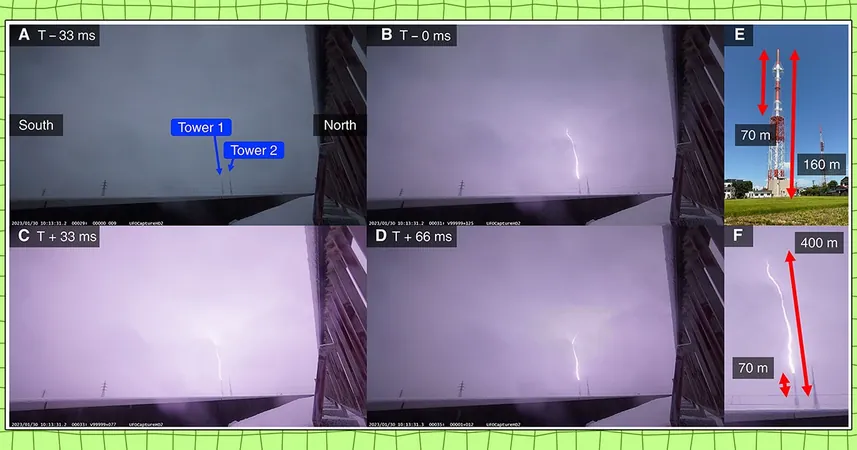
Unbelievable Discovery: Scientists Capture Moment When Two Lightning Bolts Collide and Unleash Mysterious Gamma Rays
2025-05-25
Author: Olivia
A Shocking Encounter in the Skies
What transpires just moments before two arcs of lightning collide? An astonishing surge of radiation, a million times more powerful than a typical lightning strike, bursts forth as gamma rays before vanishing almost instantaneously.
Gamma Ray Bursts: Earth Edition
Yes, you read that right! This remarkable event, akin to the cosmic explosions seen light-years away when stars go supernova, has been observed right here on Earth—though thankfully, it poses far less danger.
Groundbreaking Research Unveils Earthly Gamma Ray Blasts
For the first time ever, a group of researchers from Japan has witnessed these extraordinary earthly gamma ray blasts, termed terrestrial gamma-ray flashes, generated by lightning collisions. Their findings, published in the esteemed journal Science Advances, represent a significant leap in our understanding of gamma ray production in the tumultuous storm clouds above.
Thunderclouds: Nature's Particle Accelerators
Rich in rain and electric arcs, thunderclouds are also teeming with gamma rays. Though scientists discovered this nearly thirty years ago, the precise mechanics of how these gamma rays are created has remained elusive—until now.
Current theories suggest that thunderclouds act like natural particle accelerators, propelling electrons to speeds near that of light. Upon colliding with air molecules, these electrons unleash gamma rays, and on some occasions, even produce antimatter.
The Challenges of Capturing Dark Lightning
Documenting this phenomenon in nature has proven to be incredibly challenging. While predicting visible lightning strikes is already complex, gamma ray flashes occur approximately a thousand times less frequently, with the resulting flare lasting less than a millisecond as the rays rapidly dissipate into the atmosphere.
Ground-Based Observations Yield New Insights
Traditionally, most terrestrial gamma-ray flashes (TGFs) have been detected by satellites, which provide limited data. Lead researcher Yuuki Wada from the University of Osaka stated, "In this research, we performed a ground-based observation to see TGFs in detail."
Capturing the Collision: A Historic First
The research team deployed a sophisticated multi-sensor system, equipped to collect optical, radio frequency, and high-energy measurements from thunderstorms. Their focus was particularly on TV transmission towers, prime candidates for heavenly strikes.
The awaited moment finally arrived. Two lightning arcs converged—one, a downward-moving leader aimed at the tower, and the other, a leader ascending from the tower. In that instant, the system captured a gamma flash just 31 microseconds before their collision, occurring around 2,600 feet above ground.
The subsequent gamma ray burst flickered for about 20 microseconds, marking a historic synchronization of lightning and dark lightning through ground-based observations for the very first time.
A Step Towards Unraveling the Mysteries of Space and Lightning
Senior author Harufumi Tsuchiya expressed excitement about the findings, stating, "The multi-sensor observations performed here are a world-first; although some mysteries remain, this technique has brought us closer to understanding these fascinating radiation bursts."
Curious about Other Lightning Phenomena?
For those intrigued by the mysteries of lightning, researchers are also exploring the enigmatic flashes of light observed on Venus, connecting dots across the cosmos.









 Brasil (PT)
Brasil (PT)
 Canada (EN)
Canada (EN)
 Chile (ES)
Chile (ES)
 Česko (CS)
Česko (CS)
 대한민국 (KO)
대한민국 (KO)
 España (ES)
España (ES)
 France (FR)
France (FR)
 Hong Kong (EN)
Hong Kong (EN)
 Italia (IT)
Italia (IT)
 日本 (JA)
日本 (JA)
 Magyarország (HU)
Magyarország (HU)
 Norge (NO)
Norge (NO)
 Polska (PL)
Polska (PL)
 Schweiz (DE)
Schweiz (DE)
 Singapore (EN)
Singapore (EN)
 Sverige (SV)
Sverige (SV)
 Suomi (FI)
Suomi (FI)
 Türkiye (TR)
Türkiye (TR)
 الإمارات العربية المتحدة (AR)
الإمارات العربية المتحدة (AR)